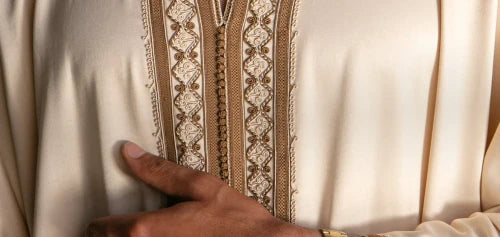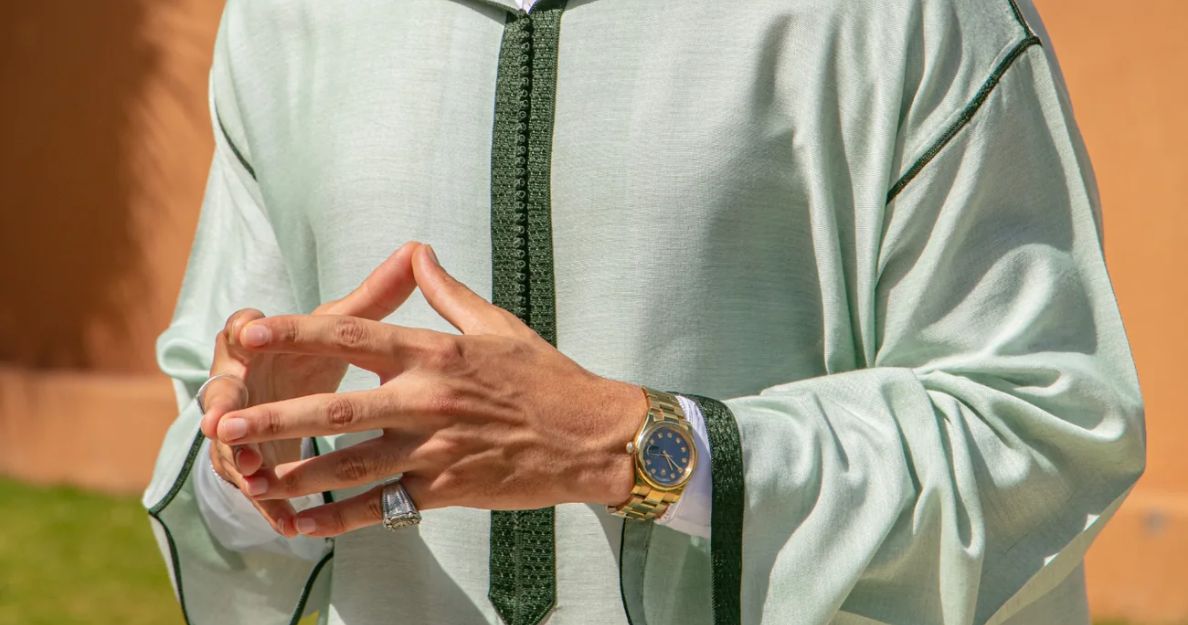The Moroccan Gandora is a beautiful and traditional garment known for its detailed designs and comfortable fit. To keep your Gandora looking its best, proper care and maintenance are essential. Whether you wear it for special occasions or as part of your everyday attire, understanding how to clean and preserve this unique piece of clothing will help extend its life and maintain its vibrant appearance. In this guide, we’ll provide practical tips and step-by-step instructions on how to care for your Moroccan Gandora, ensuring it remains a cherished part of your wardrobe for years to come.
Understanding the Fabric and Design Of Gandoras

The Moroccan Gandora is crafted from various fabrics, each requiring different care methods. Common materials include cotton, linen, silk, and blends. Cotton and linen Gandoras are breathable and durable, making them suitable for everyday wear. Silk Gandoras, on the other hand, are more delicate and often reserved for special occasions due to their luxurious feel and intricate embroidery.
Recognizing the type of fabric used in your Gandora is crucial for proper care. Delicate fabrics like silk require gentle handling and specific cleaning agents, while more robust materials like cotton and linen can withstand more rigorous cleaning methods. Additionally, the intricate designs and embellishments, such as embroidery and beadwork, should be treated with care to avoid damage. Knowing your Gandora's material and design details will help you choose the appropriate cleaning and maintenance techniques, ensuring your garment stays in excellent condition.
Pre-Cleaning Preparations
Before you begin cleaning your Moroccan Gandora, it's important to prepare properly. Start by reading and understanding the care labels on your garment. These labels provide valuable information about the recommended cleaning methods and any specific precautions to take.
Next, inspect your Gandora for any stains or damage. Identifying stains early allows you to treat them effectively, while noting any existing damage can help you avoid worsening the problem during cleaning. If there are any loose threads or minor repairs needed, address these before washing to prevent further issues.
Gather all the necessary cleaning supplies before you start. Depending on the fabric, you might need a mild detergent, a gentle stain remover, a soft brush, and access to cold or lukewarm water. Having everything ready ensures a smooth and efficient cleaning process, reducing the risk of damaging your Gandora. Preparing thoroughly will set the stage for a successful cleaning, preserving the beauty and integrity of your garment.
Cleaning Methods Of Moroccan Gandoras

Proper cleaning is vital to maintain the beauty and longevity of your Moroccan Gandora. Here are the best methods for hand washing and machine washing:
Hand Washing
Hand washing is often the safest method, especially for delicate fabrics.
- Fill a Basin: Use a basin or sink with cold or lukewarm water.
- Add Detergent: Mix in a small amount of mild detergent suitable for delicate fabrics.
- Submerge the Gandora: Gently place the Gandora in the water and let it soak for a few minutes.
- Gently Agitate: Use your hands to gently agitate the fabric, paying extra attention to areas with stains or heavy use.
- Rinse Thoroughly: Drain the soapy water and refill the basin with clean water to rinse out all detergent residues.
- Repeat if Necessary: If the Gandora is not completely clean, repeat the process with fresh water and detergent.
Machine Washing
For more robust fabrics, machine washing can be an option, but with caution.
- Use a Mesh Laundry Bag: Place the Gandora in a mesh laundry bag to protect it from rough agitation.
- Select Gentle Cycle: Set your washing machine to a gentle or delicate cycle with cold water.
- Mild Detergent: Use a mild detergent designed for delicate fabrics.
- Avoid Overloading: Do not overload the washing machine to ensure the Gandora has enough space to move freely.
By following these methods, you can effectively clean your Moroccan Gandora while preserving its fabric and design integrity.
How To Dry Your Moroccan Gandora

Proper drying techniques are essential to maintain the quality and appearance of your Moroccan Gandora. Here are the best practices for drying your garment:
Air Drying
Air drying is the safest method for most fabrics, especially delicate ones like silk.
- Lay Flat to Dry: After washing, gently squeeze out excess water without wringing the fabric. Lay the Gandora flat on a clean, dry towel.
- Shape and Smooth: Carefully shape the garment to its original form and smooth out any wrinkles.
- Avoid Direct Sunlight: Place the Gandora in a shaded area away from direct sunlight, as prolonged exposure to the sun can cause fading and damage to the fabric.
- Flip Occasionally: If drying on a flat surface, flip the Gandora occasionally to ensure even drying on both sides.
Hanging to Dry
For more robust fabrics like cotton or linen, hanging can be an option.
- Use a Padded Hanger: To prevent stretching, use a padded hanger that supports the garment’s shoulders.
- Hang Indoors: Hang the Gandora indoors in a well-ventilated area. Avoid hanging it outside where it might be exposed to dust or insects.
- Avoid Heat Sources: Do not place the Gandora near direct heat sources like radiators or heaters, as high temperatures can damage the fabric.
By following these drying methods, you ensure that your Moroccan Gandora retains its shape, colour, and overall quality. Proper drying is a crucial step in the care process, preserving the garment for continued use.
How to Iron and Steam Your Gandora

Proper ironing and steaming techniques can help keep your Moroccan Gandora looking crisp and fresh. Here’s how to handle these tasks for different fabrics:
Ironing
For fabrics like cotton and linen, ironing can remove wrinkles effectively.
- Check the Care Label: Always check the care label for ironing instructions. Some fabrics may require a low heat setting.
- Use a Pressing Cloth: Place a thin cloth between the iron and the Gandora to prevent direct heat contact, which can protect delicate embroidery or embellishments.
- Set the Right Temperature: Adjust the iron to the appropriate temperature for the fabric. For cotton, a medium to high setting works, while silk requires a very low setting.
- Iron Inside Out: Turn the Gandora inside out to avoid damaging any decorative elements.
- Iron in Sections: Iron small sections at a time, moving the iron gently and steadily to avoid scorching.
Steaming
Steaming is ideal for delicate fabrics like silk and detailed designs.
- Hang the Gandora: Hang the Gandora on a padded hanger in a well-ventilated area.
- Use a Handheld Steamer: A handheld steamer is easy to maneuver and gentle on fabrics.
- Keep Distance: Hold the steamer a few inches away from the fabric to prevent water spots and ensure even steaming.
- Steam in Vertical Strokes: Move the steamer in vertical strokes, allowing the steam to relax the fibers and remove wrinkles without direct pressure.
- Let It Air Dry: After steaming, let the Gandora hang until it is completely dry before storing or wearing it.
By following these ironing and steaming techniques, you can maintain the pristine appearance of your Moroccan Gandora without causing damage. Proper care will keep your garment looking its best for years to come.
Storing Your Gandora

Proper storage is key to preserving the quality and appearance of your Moroccan Gandora. Here are some tips to ensure your garment stays in excellent condition:
Ideal Storage Conditions
- Cool, Dry Place: Store your Gandora in a cool, dry place to prevent moisture build-up, which can lead to mold and mildew. Avoid basements or attics where temperature and humidity levels can fluctuate.
- Away from Direct Sunlight: Prolonged exposure to sunlight can fade the fabric and weaken its fibers. Store your Gandora in a shaded area.
Using Garment Bags and Padded Hangers
- Breathable Garment Bags: Use breathable garment bags made of cotton or linen to protect your Gandora from dust while allowing air circulation. Avoid plastic bags, which can trap moisture and cause the fabric to yellow over time.
- Padded Hangers: Hang your Gandora on padded hangers to maintain its shape and prevent shoulder dents. Ensure the hanger is wide enough to support the garment without stretching it.
Avoiding Moths and Other Pests
- Moth Repellents: Use natural moth repellents like cedar blocks or lavender sachets in your storage area. These can help deter pests without the harsh chemicals found in some commercial mothballs.
- Regular Inspections: Periodically check your stored Gandora for any signs of pests or damage. Early detection can prevent significant issues.
By following these storage tips, you can keep your Moroccan Gandora in pristine condition, ready to wear whenever you need it. Proper storage is an essential part of garment care, ensuring longevity and continued enjoyment of your beautiful attire.
Handling Stains and Repairs
Taking care of stains and minor repairs promptly can significantly extend the life of your Moroccan Gandora. Here’s how to handle common issues:
Treating Stains
- Identify the Stain: Determine the type of stain before treatment. Common stains include food, oil, and makeup.
- Blot, Don’t Rub: For fresh stains, gently blot the area with a clean cloth to absorb excess liquid. Avoid rubbing, as this can spread the stain and damage the fabric.
- Use Mild Stain Removers: Apply a mild stain remover suitable for delicate fabrics. Test it on an inconspicuous area first to ensure it doesn’t cause discoloration.
- Gentle Cleaning: For stubborn stains, soak the stained area in cold water mixed with a gentle detergent. Use a soft brush to lightly scrub the stain, then rinse thoroughly.
Basic Repairs
- Loose Threads: Trim any loose threads with sharp scissors. Avoid pulling on threads, as this can cause further damage.
- Small Tears and Holes: For small tears, use a needle and matching thread to sew the tear from the inside of the garment. Use small, tight stitches to secure the fabric.
- Beading and Embroidery: If beading or embroidery becomes loose, use a fine needle and matching thread to reattach them carefully. For intricate repairs, consider seeking professional help.
When to Seek Professional Help
- Severe Damage: For significant tears, large stains, or complex embroidery issues, it’s best to take your Gandora to a professional tailor or cleaner who specializes in delicate fabrics.
- Dry Cleaning: If the care label suggests dry cleaning, take your Gandora to a reputable dry cleaner experienced with handling traditional garments.
By addressing stains and repairs promptly and effectively, you can maintain the beauty and functionality of your Moroccan Gandora, ensuring it remains a cherished part of your wardrobe for years to come.
Tips for Long-Term Maintenance
Maintaining your Moroccan Gandora over the long term involves regular care and attention. Here are some tips to keep your garment in excellent condition:
Regular Cleaning Schedule
- Consistent Care: Establish a regular cleaning routine based on how often you wear your Gandora. Frequent use may require more frequent cleaning, while occasional wear can be managed with less frequent washing.
- Seasonal Cleaning: At the end of each season, clean your Gandora before storing it away. This helps remove any accumulated dirt and prevents stains from setting over time.
Rotating Your Gandora
- Prevent Overuse: If you have multiple Gandoras or similar garments, rotate them to prevent excessive wear on any single piece. This helps extend the life of each garment.
- Varied Use: Avoid wearing the same Gandora for consecutive days. Giving it a rest between uses allows the fabric to recover and reduces wear and tear.
Special Occasion Care
- Handling Delicate Fabrics: For Gandoras made of delicate materials like silk, reserve them for special occasions to minimise wear. Handle them with extra care to prevent damage.
- Storing After Events: After wearing your Gandora to an event, clean it promptly to remove any stains or odours. Proper cleaning and storage will keep it ready for the next special occasion.
Addressing Wear and Tear
- Regular Inspections: Periodically inspect your Gandora for signs of wear and tear. Early detection of issues like loose threads or small tears can prevent more significant damage.
- Preventive Measures: Take preventive measures such as using garment bags, padded hangers, and moth repellents to protect your Gandora from common hazards.
By following these long-term maintenance tips, you can ensure that your Moroccan Gandora remains a beautiful and cherished garment for many years. Regular care and mindful use will preserve its quality and keep it looking as stunning as the day you first wore it.
Conclusion
Caring for your Moroccan Gandora properly ensures it remains a stunning and cherished part of your wardrobe. By understanding the fabric and design, preparing adequately before cleaning, and choosing the right cleaning methods, you can maintain its beauty and longevity. Proper drying, ironing, and steaming techniques further protect the garment, while careful storage prevents damage over time. Addressing stains and repairs promptly, along with regular maintenance, will keep your Gandora in excellent condition for years to come. With these tips and guidelines, you can enjoy your Moroccan Gandora at its best, preserving its elegance and cultural significance.









